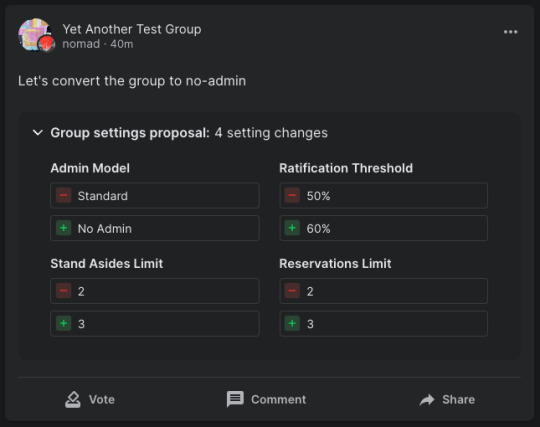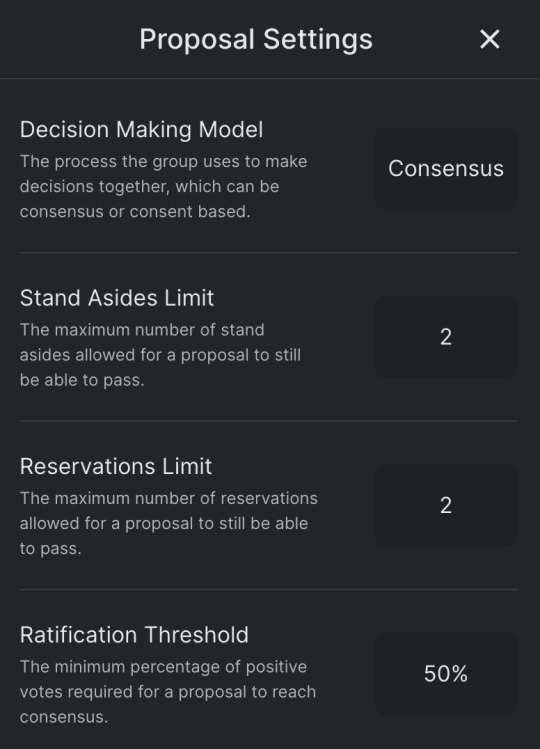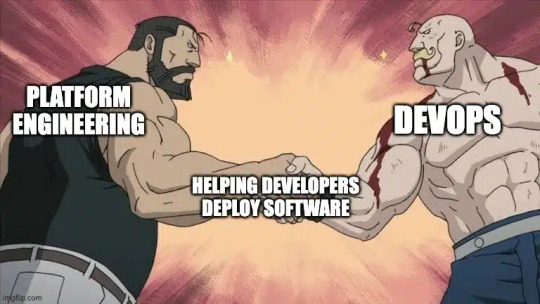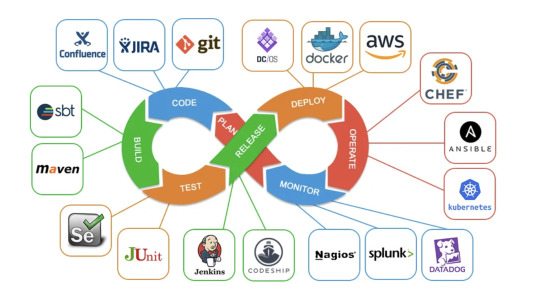#software testing engineer
Explore tagged Tumblr posts
Text


Since our last release, we've introduced several significant updates, with one of the key enhancements being proposals to change group settings. This enables group members to collectively shape the group's overall functionality and tailor it to better suit their needs and preferences as the group evolves over time.
In addition to the ability to propose changes, we've introduced the following group settings:
Decision Making Model - You can now choose from consensus or consent decision-making to determine how decisions are made in the group
Admin Model - Choose from No Admin or Standard to determine how the group is managed. No Admin ensures all changes are made through proposals, while Standard allows for customizable admin roles
Ratification Threshold - Set the minimum amount of positive votes required for a proposal to be ratified under consensus
Voting Time Limit - Set a time limit for how long proposals can be voted on before they're closed or ratified. This can be set with a dropdown or a date picker
Stand Asides and Reservations Limit - Set the acceptable number of stand asides or reservations for a proposal to pass
These updates aim to offer greater customization for groups, while also showcasing how software can empower communities to collectively shape the digital spaces they occupy.
For anyone interested in helping to test the new features, feel free to hit us up on here or Discord.
Join the Praxis Discord - Mastodon - GitHub
#open source#praxis#free software#typescript#nodejs#foss#reactjs#design#graphql#software testing#software#software engineering
49 notes
·
View notes
Text
SPARK TECHNOLOGIES
We deliver value by identifying opportunities that align with business objectives and adopting an agile approach to implement them.
#Web developement#Software testing#Devops & Engineering#Salesforce#Mobile Application Developmen#Data Analytics#IT Consulting#IT Outsourcing#Web Design#Content Management System#Digital Marketing
2 notes
·
View notes
Text
SPARK TECHNOLOGIES
We will strive to surpass our clients’ expectations by providing innovative solutions that are grounded in science and experience, developed by recognized experts, and delivered in a trusted manner above reproach. We will remain steadfastly focused on our clients’ goals and work every day to ensure that the issues of current importance, which they are charged with solving, are moved closer to a proven and cost-effective resolution.
#web developement#software testing#devas & Engineering#salesforce#mobile app development#data analytics#it consulting#it outsourcing#web design#content management system#digital marketing
2 notes
·
View notes
Text
I will continue being gone for a few days, sadly my original al plan of releasing the newest chapter of The Consequence Of Imagination's Fear has also been delayed. My apologies
Can't go into detail because its hush hush not-legally-mentionable stuff but today is my fifth 12 hour no-break work day. I'm also packing to move too in a fortnight (which is a Big Yahoo!! Yippee!! I'll finally have access to a kitchen!! And no more mold others keep growing!!! So exciting!!!)
#syncrovoid.txt#delete later#OKAY SO! this makes it sound like i have a super important job but really we are understaffed and ive barely worked there a year now#graduated college a few years early 'cause i finished high school early (kinda? it's complicated)#now i am in a position where i am in the role of a whole Quality Assurance team (testing and write ups)#a Task Manager/Planner#Software Developer and maybe engineer? not sure the differences. lots of planning and programming and debugging ect ect#plus managing the coworker that messed up and doing his stuff because it just isnt good enough. which i WILL put in my end day notes#our team is like 4 people lol. we severely need more because rhe art department has like 10 people??#crunch time is.. so rough..#its weirdddddd thinking about this job since its like i did a speedrun into a high expectations job BUT in my defense i was hired before#i graduated. and like SURE my graduating class had literally 3 people so like there was a 86%-ish drop out rate??#did a four year course in 2 BY ACCIDENT!! i picked it on a whim. but haha i was picked to give advice and a breakdown on the course so it#could be reworked into a 3 year course (with teachers that dont tell you to learn everything yourself) so that was neat#im rambling again but i have silly little guy privileges and a whole lot of thoughts haha#anywho i am SO hyped to move!! I'll finally get away from the creepy guy upstairs (i could rant for days about him but he is 0/10 the worst)#it will be so cool having access to a kitchen!! and literally anything more than 1 singular room#(it isnt as bad as it sounds i just have a weird life. many strange happenings and phenomenons)#<- fun fact about me! because why not? no one knows where i came from and i dont 100% know if my birthday is my birthday#i just kinda. exist. @:P#i mean technically i was found somewhere and donated to some folks (they called some different people and whoever got there first got me)#but still i think it is very silly! i have no ties to a past not my lived one! i exist as a singularity!#anywho dont think about it too hard like i guess technically ive been orphaned like twice but shhhhhhhh#wow. i am so sleep deprived. i am so so sorry to anyone who may read this#i promise im normal#@:|
8 notes
·
View notes
Text
In this video, I will give a short description of the definition of software quality assurance.
#sqa#software quality assurance#software testing#software engineering#software development#freelance#Freelacer Manan Broti#Manan Broti
2 notes
·
View notes
Text
Quality Engineering and Digital Transformation Services - QualiZeal
Our Next Gen Quality Assurance & Engineering Services pave the way for accelerated digital growth. Drive faster time to market and assure success for enterprise software in the connected world.
Visit for more info:
https://qualizeal.com/
2 notes
·
View notes
Text
0 notes
Text
Loving Travis
For most of my open-source software projects, I use the Actions platform built into GitHub for CI (continuous integration). GitHub Actions provides virtual machines to run workflows, so I don't have to administer build environments for Linux, MacOS, Windows, and so on. It's modern, convenient (if you use GitHub instead of, say, GitLab), fairly reliable, and (best of all) free (for public repos).
For me, the main limitation of Actions is that all their hosted runners use the x64 architecture. Sometimes I want to build and/or test on Arm CPUs---for instance my Libbulletjme project, which has a bunch of platform-sensitive C++ code.
For Libbulletjme, I still depend on the older TravisCI platform, run by a private firm in Berlin. In addition to a huge selection of build environments based on AMD CPUs, Travis also provides Arm-based Linux environments. (Officially, they're a "beta-stage" feature, but they've been in beta for years.) Like Actions, Travis is also free to open-source projects, though their notion of "open-source" seems a bit stricter than GitHub's.
I mention Travis because my experiments with the Vulkan API exposed a limitation in Libbulletjme, which led me to begin work on a new release of Libbulletjme, which led me to discover an issue with Travis's Arm-based build environments. A recent change to these environments caused all my Arm-based builds to fail. I could only go a bit further with Vulkan before I would have to make hard choices about how to work around the limitations of Libbulletjme v18.5.0 .
At 20:09 hours UTC yesterday (a Sunday), I e-mailed TravisCI customer support and explained my issue. At 12:25 hours UTC today, Travis announced a hotfix to solve my issue. That's pretty good turnaround, for a non-paying customer having issues with a "beta-stage" feature on a summer weekend.
Bottom line: I still love Travis. <3
#continuous integration#vulkan#computer architecture#software engineering#open source#github#hosting#upcoming releases#customer support#making progress#software testing#war stories#love#berlin
3 notes
·
View notes
Text
Discover how Artificial Intelligence is transforming the entire software development lifecycle (SDLC) — from requirements gathering to deployment and maintenance. In this article, we explore how AI tools boost productivity, enhance quality, and reshape the way teams build modern software. Learn how developers and organizations can harness AI as a powerful collaborator in creating faster, smarter, and more reliable applications.
#AI#Architecture Analysis#Artificial Intelligence#Automated Testing#Coding Phase#Design#Detailed Design#Operating Software#Requirements Elicitation#SDLC#Shifting Left Security#Shifting Left Testing#Software Architecture#Software Construction#Software Deployment#Software Development#Software Development Life Cycle#Software Development Process#Software Engineering#Software Maintenance#Software Retirement
0 notes
Text
Software Testing Training Course
A Software Testing Course is all about giving thorough hands-on training to students who want to test software applications. The course begins with an introduction to software testing and talks about the importance of testing in the software development life cycle (SDLC), development cycle, through which testing manages the quality, functionality, and reliability of software products. Meanwhile, the students would have covered various types of testing at different levels: unit testing, integration testing, system testing, user acceptance testing, functional testing, and non-functional testing. Manual testing comes first, where students practice writing test cases, executing them, reporting bugs, and learning the defect life cycle using tools like JIRA or Bugzilla. Automation has become integral to testing since the evolution of software development, and automation testing takes a huge share of this course. Students learn to write test scripts using popular tools like Selenium, TestNG, and Postman Coding Bit. Beside these tools, the course covers basic programming skills (usually in Java or Python). Students learn to write simple scripts, use conditional statements, loops, and functions, which provide the necessary backbone for building automation frameworks for API or UI testing. Advanced topics may include CI/CD with Jenkins, version control with Git, and behavior-driven development (BDD) with Cucumber. With hands-on projects and real-life case studies, several software testing courses also prepare students for certification such as ISTQB or CSTE, thereby enhancing their employability. These courses are best suited for freshers, manual testers who wish to jump into automation, and people from non-IT fields who strive to create an IT career. Rising needs for quality software assured software testing remains a highly valued and in-demand skill across various industries.
Types of Testing
Explore different types of testing, including:
Functional Testing
Non-functional Testing (Performance, Usability, Security)
Regression Testing
Smoke and Sanity Testing
Automated Testing 📞 Phone Number: +91 9511803947 📧 Email Address: [email protected]

#Manual Testing#Quality Assurance Testing#Software Testing Course#Learn Software Testing#Testing Training#QA Engineer#Software Quality#Bug Hunting
0 notes
Text
[Image description: a social media post by carlinm.horger which says "I think I have the perfect question to ask if we want DEI..
if you and your family are taking a flight, who do you want piloting that plane? A merit based applicant, or, a DEI?"
rob.unsupervised replies "Pilot here.
This is a stupid fucking question. Stop asking it.
Any female, black, Hispanic, Asian, native, Arabic, Jewish, or fucking Martian pilot you see passed the same licensing tests as I did.
The FAA doesn't lower their standards for anyone. Ever.
Standards are standards. DEI doesn't mean lower standards. It means a pilot who meets the standards doesn't get passed over because they don't look exactly like me."
joycelynnknowsmoney replies "Why do people think DEI = unqualified?"]

DEI does not mean lower standards.
You are thinking of white privilege.
#also black doctors are often better for black patients because they'll have insights that nonblack doctors simply will not have#and cannot be taught#diversity#i can back up the engineering claim as well: does anyone remember the trouble of facial recognition software and eye tracking software#or even fucking soap dispensers not working on people with dark skin?#thats because the software was completely trained on a pale dataset and no one thought to test it on different skin tones#ONE black engineer or another dark skinned engineer would have caught that issue immediately when they tested it themselves
79K notes
·
View notes
Text
Platform Engineering Vs Devops: Difference In 2025

Let’s start with DevOps, the buzzword that changed how we think about building and shipping software. These days, every college student and other professional wants to become a DevOps engineer. If you are an aspiring DevOps engineer or already working as a DevOps engineer, this blog will help you understand the difference between Platform engineering and Devops
Platform engineering is really changing every company’s perspective on developing platforms. These days, every company has started building its own internal developer platform (IDP). Let’s see why platform engineering is so important and whether platform engineering is replacing DevOps.
What is DevOps?
If you see the definition of DevOps online, this is what you get to see:
“DevOps is the combination of cultural philosophies, practices, and tools that increases an organization’s ability to deliver applications and services at high velocity.”
The goal? To shorten the software development life cycle and deliver high-quality software quickly and reliably. It’s all about collaboration, automation, and breaking down silos between teams.
But DevOps isn’t just about tools. It’s about people working together, sharing responsibility for building, testing, and releasing code. Think of it as a bridge that connects development and operations, powered by automation and transparency.
Now let’s come to our hero.

What is Platform Engineering?
Platform engineering focuses on designing, building, and maintaining the internal platforms that software teams use to build, test, deploy, and operate applications. These platforms aim to make developers’ lives easier by providing self-service tools, infrastructure as code, automation, and standardized processes.
If DevOps is the bridge, platform engineering is like building a really smart highway system on top of it.
Imagine you’re a developer. Instead of dealing with infrastructure headaches every time you want to deploy something, a platform engineer has already built you a “golden path”—a toolkit that lets you focus on your code and ship it faster (and safer).
For example, if you are a developer who needs access to a K8s cluster, instead of waiting for DevOps team or your manager to give you access, imagine if there is a platform (Internal Developer platform) where you can self-provision everything without needing to wait for anyone. How cool is this, right?
How are Platform Engineering and DevOps Different?
At a first glance, DevOps and platform engineering can look pretty similar—they both want to speed up delivery, improve collaboration, and automate all the things. But here’s the big difference:
DevOps is a set of practices and a cultural movement. It encourages developers and operations to work together, adopt automation, and own the entire lifecycle.
Platform Engineering is about productizing infrastructure and tooling. Platform engineers build the reusable platforms, paved roads, and self-service portals that enable DevOps to scale across a company.
How to Get Started with DevOps?
To be honest, the answer will differ. From a company perspective, they may already be implementing DevOps and have DevOps engineers in place. But if you are someone new to DevOps and want to start learning, here’s how you can begin:
First, start with containers and try to containerize your application. Once you are familiar with containerization technology, learn CI/CD. Then, start using any of the popular cloud platforms to deploy your application. Finally, explore Kubernetes. These are tools in DevOps, but you don’t need to learn every tool—focus on learning the technology behind them.
For example, learn containerization technology first before diving into Docker or Podman. The same applies to all tools: understand the underlying technology first, then use the tools.
How to Get Started with Platform Engineering?
I know everyone has this question: How do I get started with Platform Engineering? My first recommendation is to use tools that provide platforms or help in building platforms. This will give you a better understanding of how platform engineering works. Learning theory, like reading this blog, is fine, but try using tools that are useful for building platforms. There are many tools on the market, like Backstage, and the most popular tool I would recommend is Crossplane. Use these tools and then analyze how they can be used to build platforms that solve the internal issues developers are currently facing.
Also, join the Platform Engineering community. The CNCF has a dedicated working group for Platform Engineering. You can join the community and learn how others are building platforms.
How to Implement DevOps

How to Implement Platform Engineering
Understand Developer Needs: Interview your dev teams. What slows them down? What do they need to move faster?
Design for Self-Service: Build tools and platforms that let developers help themselves.
Standardize and Automate: Use Infrastructure as Code (IaC), CI/CD pipelines, and reusable modules.
Feedback Loop: Keep talking to your users (the devs) and keep improving the platform.
Measure Success: Track adoption, developer satisfaction, and the time it takes to deliver features.
Is Platform Engineering Replacing DevOps?

It’s a question a lot of people are asking as platform engineering gains popularity: Is platform engineering replacing DevOps?
The short answer is no platform engineering is not replacing DevOps. Instead, it’s building on the foundation that DevOps created.
DevOps introduced the world to better collaboration, automation, and a culture of shared responsibility between development and operations. Platform engineering takes these ideas a step further by creating internal platforms and tools that make it easier for teams to practice DevOps at scale.
Think of it like this:
DevOps is about changing how teams work together and automate software delivery.
Platform engineering is about building what teams use internal products, self-service tools, and reusable systems that support DevOps practices.
In fact, platform engineering and DevOps go hand in hand. Platform engineering empowers DevOps teams to work more efficiently and consistently, while DevOps culture ensures that platforms are used and improved collaboratively. Rather than a replacement, platform engineering is the next evolution that helps organizations get even more value out of DevOps.
Integrate Keploy into Your CI/CD Pipeline for Continuous Testing
In a typical CI/CD pipeline, I’m sure everyone has integrated some static tools and security tools. But what if there's something we can add for testing? Yes, you can add Keploy to your CI/CD pipeline so that testing becomes a part of it. This way, every time you make changes, testing is included, and you can identify bugs and confirm if any new regressions have been introduced.
No matter where your CI/CD pipeline is whether it’s in GitHub, GitLab, or Jenkins you can run Keploy.
To learn more about Keploy integration with GitHub: https://keploy.io/docs/ci-cd/github/
To learn more about Keploy integration with Gitlab: https://keploy.io/docs/ci-cd/gitlab/
To learn more about Keploy integration with Jenkins: https://keploy.io/docs/ci-cd/jenkins/
Benefits of DevOps
Faster releases: Automate everything from builds to deployment.
Better collaboration: No more “throwing code over the wall.”
Higher reliability: Automated tests and monitoring catch issues earlier.
Continuous improvement: Feedback loops make processes better over time.
More fun at work: Developers and ops feel like they’re on the same team.
Benefits of Platform Engineering
Self-service: Developers don’t have to wait for ops to provision resources.
Consistency: Standardized tools and processes across teams.
Scalability: Easy to grow as your organization grows.
Happier developers: Less time fighting with infrastructure, more time coding.
Security and compliance: Built-in guardrails keep your cloud safe.
Conclusion:
I hope you had some insight on platform engineering and DevOps. I guess DevOps people already know and have used DevOps, but platform engineering is something new to many people. Many organizations have started investing in platform engineering, so it is good to know about these concepts. More importantly, if you are a DevOps engineer, start investing in yourself on platform engineering. Build some simple platforms, do POCs, and then you will understand the importance of platform engineering and how it will improve your team’s productivity.
FAQs:
1. Can you have DevOps without platform engineering? Yes DevOps can work with manual processes or basic automation, but it scales better with a strong platform.
2. Does platform engineering replace DevOps? No. Platform engineering empowers DevOps by providing better tools and reusable infrastructure.
3. Is platform engineering only for big companies? No. Even small teams can benefit from simple platforms, especially as they grow.
4. What skills do platform engineers need? Cloud, automation, programming, CI/CD, and empathy for developers’ pain points.
5. Which roles should own developer experience—DevOps or platform engineering? Both have a stake, but platform engineers are increasingly focused on developer experience as their main product.
0 notes
Text
Secure, Scalable, and Built for the Field: Atcuality Delivers
Atcuality is a technology partner focused on solving complex operational challenges with smart, mobile-based business tools. Whether you need to digitize reporting, track transactions, or reduce cash handling risks, our products are engineered with flexibility and performance in mind. Our cash collection application is trusted by logistics and field-service teams across industries to simplify collections and strengthen financial accountability. Key features include instant receipt generation, GPS verification, automated daily summaries, and bank reconciliation support—all accessible from any Android device. With real-time dashboards and customizable workflows, it turns every delivery or collection point into a transparent, auditable node in your finance system. Trust Atcuality to help your business operate faster, safer, and smarter—right from the ground up.
#artificial intelligence#ai applications#augmented and virtual reality market#digital marketing#emailmarketing#augmented reality#web development#website development#web design#information technology#website optimization#website#websites#web developing company#web developers#website security#website design#website services#ui ux design#wordpress#wordpress development#webdesign#digital services#digital consulting#software development#software testing#software company#software services#machine learning#software engineering
0 notes
Text
Full Stack Development Course: Roadmap, Skills, and Job Opportunities
In today's digital era, businesses are constantly seeking tech professionals who can build and manage complete web applications independently. This is where Full Stack Development shines. With the demand for full stack developers on the rise, now is the perfect time to enroll in a Full Stack Development Course and kickstart a career in one of the most versatile roles in the IT industry.
If you're looking for the best place to learn, Be-Practical, an educational and training organization based in Bangalore, offers a comprehensive full stack developer course in Bangalore that combines industry-relevant skills with practical learning and guaranteed placement support.
In this blog, we’ll explore the roadmap to becoming a full stack developer, the key skills you’ll gain, and the job opportunities available after completing a full stack development course in Bangalore.

📍 What is Full Stack Development?
Full stack development refers to the process of developing both the front-end (client side) and back-end (server side) of web applications. A Full Stack Developer is a professional capable of handling the entire application development process—from user interface design to server and database management.
Given the dynamic nature of web technologies, companies prefer hiring full stack developers who can manage end-to-end projects with minimal dependency.
🎓 Why Choose Be-Practical?
Be-Practical is a trusted name in IT education and training, especially in the domain of full stack development course in Bangalore. With an emphasis on hands-on learning, real-time projects, and industry mentorship, Be-Practical prepares students to meet real-world development challenges head-on.
Their full stack developer course in Bangalore with placement offers dedicated career guidance, resume building sessions, and mock interviews to ensure you're fully prepared to land your dream job.
🛣️ Full Stack Development Course Roadmap
A well-structured Full Stack Development Course is typically divided into three main layers:
1. Front-End Development
You’ll begin by learning how to build user interfaces using:
HTML5 & CSS3 – For structuring and styling web content.
JavaScript – The programming language that powers interactivity.
React.js or Angular – For building responsive, single-page applications (SPAs).
The full stack developer course at Be-Practical ensures you master these tools to design seamless, responsive websites that provide a rich user experience.
2. Back-End Development
Next, you’ll explore the server side of web development, including:
Node.js & Express.js – Popular technologies for building scalable server-side applications.
Java or Python (optional) – Additional languages used by many enterprise-grade applications.
REST APIs – For client-server communication.
The full stack development course in Bangalore by Be-Practical offers practical training in server-side logic, database integration, and session handling.
3. Database Management
Databases are crucial for any application. You’ll learn how to:
Design and manage SQL databases (MySQL, PostgreSQL)
Work with NoSQL databases like MongoDB
Integrate databases with front-end and back-end using full stack frameworks
4. DevOps & Deployment
Be-Practical’s full stack developer course in Bangalore with placement also covers deployment fundamentals:
Version control with Git & GitHub
Hosting applications using Heroku, Netlify, or AWS
Introduction to CI/CD pipelines and cloud environments
This makes you job-ready and confident in deploying real-world projects to live environments.
🧠 Essential Skills You’ll Learn
By the end of your Full Stack Development Course, you’ll have hands-on experience with the following:
Writing clean, efficient HTML, CSS, and JavaScript code
Creating dynamic front-end applications with React
Building scalable back-end APIs using Node.js and Express
Managing relational and non-relational databases
Using Git and GitHub for version control and collaboration
Deploying full stack projects in cloud environments
Debugging and testing applications
Soft skills like communication, teamwork, and problem-solving
These skills are taught through project-based learning at Be-Practical, ensuring you apply everything you learn in real-time scenarios.
💼 Career and Job Opportunities
The demand for full stack developers is booming across India and globally. After completing a full stack developer course, you can explore roles such as:
Full Stack Developer
Web Developer
Front-End Developer
Back-End Developer
Software Engineer
UI/UX Developer
Application Developer
Top tech companies, startups, and MNCs are actively hiring professionals who can manage entire application life cycles. According to job market reports, full stack developers in India earn between ₹4 LPA to ₹15 LPA based on experience and skill level.
Be-Practical’s full stack developer course in Bangalore with placement ensures you don’t just learn the skills—you get placed in the right job with the right package.
📍 Why a Full Stack Developer Course in Bangalore?
Bangalore is India’s tech hub, home to thousands of IT companies, startups, and R&D centers. Choosing a full stack development course in Bangalore puts you in proximity to top employers and opens up numerous networking and internship opportunities.
Be-Practical’s industry partnerships and local employer connections make it one of the best places to take a full stack developer course in Bangalore and get placed quickly.
🎯 Final Thoughts
Whether you’re a student, a working professional looking for a career switch, or someone seeking a high-paying job in IT, a Full Stack Development Course is your ticket to long-term success.
Be-Practical offers one of the most comprehensive and job-focused full stack developer course in Bangalore with placement, equipping you with technical skills, soft skills, and industry exposure.
Start your journey today with Be-Practical and become a confident, competent full stack developer ready to take on the digital world.
0 notes
Text
Catching up
My health issue appears to be resolved, though I am avoiding strenuous exercise for the time being.
Today I pushed all my MonkeyWrench changes to the public repo at GitHub, including the test app.
Next up: assess how well MonkeyWrench loads various test models compared to the standard jme3-plugins loaders in the JMonkeyEngine game engine.
#wip#open source#github#software development#accomplishments#3d model#3d graphics#game engine#software testing#future plans#coding
4 notes
·
View notes
Text
Unlocking the Power of Generative AI & Prompt Engineering for QA Engineers
In today's fast-evolving software landscape, Quality Assurance (QA) is no longer confined to traditional manual testing methods. The integration of Generative AI and Prompt Engineering is revolutionizing how QA engineers design, execute, and manage testing processes. Magnitia’s course on Generative AI & Prompt Engineering for QA Engineers is tailored to empower professionals with the knowledge and skills to stay ahead in this AI-driven era.
Why QA Needs Generative AI
Generative AI, such as ChatGPT and similar LLMs (Large Language Models), can produce human-like text and logic-based outputs. For QA professionals, this means:
Automated test case generation based on user stories or requirements
Bug report summarization and prioritization
Smart script generation for automation frameworks like Selenium or Playwright
Instant documentation creation for better traceability
When applied properly, Generative AI can drastically reduce time-to-test while increasing coverage and accuracy.
What is Prompt Engineering?
Prompt engineering is the process of crafting precise and efficient prompts to communicate with AI models. For QA engineers, mastering this skill means:
Generating highly accurate test cases from vague inputs
Extracting specific validation scenarios from documentation
Building reusable QA templates that AI can use consistently
Validating functional and edge cases through AI simulations
Course Overview at Magnitia
The Generative AI & Prompt Engineering for QA Engineers course offers a hands-on, project-based approach. Here’s what learners can expect:
Key Modules:
Introduction to Generative AI in QA
Fundamentals of Prompt Engineering
Crafting Test Cases using AI
Automating Regression and Unit Testing with AI Tools
Writing Functional Test Scenarios from Business Requirements
Enhancing Defect Analysis and Reporting with AI
Integration with Testing Frameworks and CI/CD Pipelines
Real-time Project Simulations and Case Studies
Tools Covered:
OpenAI (ChatGPT)
GitHub Copilot
Test Automation tools (Playwright, Selenium)
AI-based documentation tools
API testing with Postman & AI plugins
Who Should Enroll?
This course is ideal for:
Manual testers looking to transition into automation
Automation testers wanting to enhance productivity
QA leads and managers aiming to optimize testing processes
Anyone interested in AI’s role in Quality Engineering
Benefits of the Course
Industry-relevant curriculum aligned with real-world applications
Expert-led sessions with insights from AI and QA veterans
Hands-on projects to build practical experience
Certification to validate your AI & QA integration skills
Career support including mock interviews and resume guidance
Future-Proof Your QA Career
As AI continues to reshape the technology landscape, QA engineers must adapt and evolve. By mastering generative AI and prompt engineering, QA professionals not only increase their value but also contribute to faster, smarter, and more resilient testing strategies.
Enroll now at Magnitia to harness the full potential of Generative AI in QA and become a leader in the next generation of software testing.
0 notes